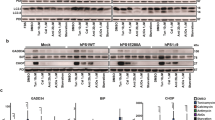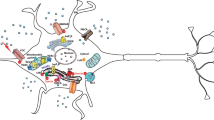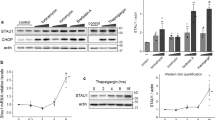Abstract
Most early-onset familial Alzheimer disease (AD) cases are caused by mutations in the highly related genes presenilin 1 (PS1) and presenilin 2 (PS2)1,2,3. Presenilin mutations produce increases in ß-amyloid (Aß) formation and apoptosis in many experimental systems. A cDNA (ALG-3) encoding the last 103 amino acids of PS2 has been identified as a potent inhibitor of apoptosis4,5. Using this PS2 domain in the yeast two-hybrid system, we have identified a neuronal protein that binds calcium and presenilin, which we call calsenilin. Calsenilin interacts with both PS1 and PS2 in cultured cells, and can regulate the levels of a proteolytic product of PS2. Thus, calsenilin may mediate the effects of wild-type and mutant presenilins on apoptosis and on Aß formation. Further characterization of calsenilin may lead to an understanding of the normal role of the presenilins and of the role of the presenilins in Alzheimer disease.
This is a preview of subscription content, access via your institution
Access options
Subscribe to this journal
Receive 12 print issues and online access
$209.00 per year
only $17.42 per issue
Buy this article
- Purchase on Springer Link
- Instant access to full article PDF
Prices may be subject to local taxes which are calculated during checkout



Similar content being viewed by others
References
Sherrington,R, et al.Cloning of a gene bearing missense mutations in early-onset familial Alzheimer's disease. Nature 375, 754–760 (1995).
Levy-Lahad, E. et al.Candidate gene for the chromosome 1 familial Alzheimer's disease locus. Science 269, 973– 977 (1995).
Rogaev, E.I. et al.Familial Alzheimer's disease in kindreds with missense mutations in a gene on chromosome 1 related to the Alzheimer's disease type 3 gene. Nature 376, 775–778 (1995).
Vito, P., Lacana, E. & D'Adamio, L. Interfering with apoptosis: Ca(2+)-binding protein ALG-2 and Alzheimer's disease gene ALG-3. Science 271, 521–525 (1996).
Vito, P. et al. Requirement of the familial Alzheimer's disease gene PS2 for apoptosis. Opposing effect of ALG-3. J. Biol. Chem. 271, 31025–31028 (1996).
Hardy, J. Amyloid, the presenilins and Alzheimer's disease. Trends Neurosci. 20, 154-159 (1997 ).
Mattson, M.P., Guo, Q., Furukawa, K. & Pedersen, W.A. Presenilins, the endoplasmic reticulum, and neuronal apoptosis in Alzheimer's disease. J. Neurochem. 70, 1–14 (1998).
Nomura, N. et al. Prediction of the coding sequences of unidentified human genes. II. The coding sequences of 40 new genes (KIAA0041-KIAA0080) deduced by analysis of cDNA clones from human cell line KG-1. DNA Res. 1, 223–229 ( 1994).
Kim, T.W. et al. Endoproteolytic cleavage and proteasomal degradation of presenilin 2 in transfected cells. J. Biol. Chem. 272, 11006–11010 (1997).
Dizhoor, A.M. et al. Recoverin: a calcium sensitive activator of retinal rod guanylate cyclase. Science 251, 915– 918 (1991).
Kobayashi, M., Takamatsu, K., Saitoh, S., Miura, M. & Noguchi, T. Molecular cloning of hippocalcin, a novel calcium-binding protein of the recoverin family exclusively expressed in hippocampus. Biochem. Biophys. Res. Commun. 189, 511–517 (1992).
Nef, S., Fiumelli, H., de Castro, E., Raes, M.B. & Nef, P. Identification of neuronal calcium sensor (NCS-1) possibly involved in the regulation of receptor phosphorylation. J. Recept. Signal Transduct. Res. 15, 365– 378 (1995).
Kim, T.-W., Pettingell, W.H., Jung, Y.-K., Kovacs, D.M. & Tanzi, R.E. Alternative cleavage of Alzheimer-associated presenilins during apoptosis by a caspase-3 family protease. Science 277, 373–376 ( 1997).
Loetscher, H. et al. Presenilins are processed by caspase-type proteases. J. Biol. Chem. 272, 20655–20659 (1997).
Zhou, J. et al. Presenilin 1 interaction in the brain with a novel member of the Armadillo family. Neuroreport 8, 2085 –2090 (1997).
Zhang, W., Han, S.W., McKeel, D.W., Goate, A. & Wu, J.Y. Interaction of presenilins with the filamin family of actin-binding proteins. J. Neurosci. 18, 914–922 (1998).
Shinozaki, K. et al. The presenilin 2 loop domain interacts with the μ-calpain C-terminal region. Int. J. Mol. Med. 1, 797–799 (1998).
Guo, Q., Christakos, S., Robinson, N. & Mattson, M.P. Calbindin D28k blocks the proapoptotic actions of mutant presenilin 1: Reduced oxidative stress and preserved mitochondrial function. Proc. Natl. Acad. Sci. USA 95, 3227–3232 (1998).
Buxbaum, J.D., Ruefli, A.A., Parker, C.A., Cypess, A.M. & Greengard, P. Calcium regulates processing of the Alzheimer amyloid protein precursor in a protein kinase C-independent manner. Proc. Natl. Acad. Sci. USA 91, 4489 –4493 (1994).
Querfurth, H.W. & Selkoe, D.J. Calcium ionophore increases amyloid beta peptide production by cultured cells. Biochemistry 33, 4550–4561 ( 1994).
Thinakaran, G. et al. Evidence that levels of presenilins (PS1 and PS2) are coordinately regulated by competition for limiting cellular factors. J. Biol. Chem. 272, 28415–28422 (1997).
Keller, J.N., Guo, Q., Holtsberg, F.W., Bruce-Keller, A.J. & Mattson, M.P. Increased sensitivity to mitochondrial toxin-induced apoptosis in neural cells expressing mutant presenilin-1 is linked to perturbed calcium homeostasis and enhanced oxyradical production. J. Neurosci. 18, 4439–4450 ( 1998).
Acknowledgements
We thank C. Fredholm for doing 5'-RACE to verify the 5' sequence of calsenilin, K.-N. Liu for preparing and purifying GST–calsenilin, and P. Allen for his excellent advice on the two-hybrid system. This work was supported by grants from the Neuroscience Education and Research Foundation (to J.D.B.), the Alzheimer Association (to J.D.B. and W.W.), the NINDS (to W.W.), and the Korea Research Foundation (E.-K.C.). W.W. is a Pew Scholar.
Author information
Authors and Affiliations
Corresponding author
Rights and permissions
About this article
Cite this article
Buxbaum, J., Choi, EK., Luo, Y. et al. Calsenilin: A calcium-binding protein that interacts with the presenilins and regulates the levels of a presenilin fragment. Nat Med 4, 1177–1181 (1998). https://doi.org/10.1038/2673
Received:
Accepted:
Issue Date:
DOI: https://doi.org/10.1038/2673
This article is cited by
-
A semi-supervised approach for the integration of multi-omics data based on transformer multi-head self-attention mechanism and graph convolutional networks
BMC Genomics (2024)
-
Impact of beta-tricalcium phosphate on preventing tooth extraction-triggered bisphosphonate-related osteonecrosis of the jaw in rats
Scientific Reports (2023)
-
Ifenprodil Reduced Expression of Activated Microglia, BDNF and DREAM Proteins in the Spinal Cord Following Formalin Injection During the Early Stage of Painful Diabetic Neuropathy in Rats
Journal of Molecular Neuroscience (2021)
-
Targeting the neuronal calcium sensor DREAM with small-molecules for Huntington’s disease treatment
Scientific Reports (2019)
-
Control of Neuronal Ryanodine Receptor-Mediated Calcium Signaling by Calsenilin
Molecular Neurobiology (2019)



